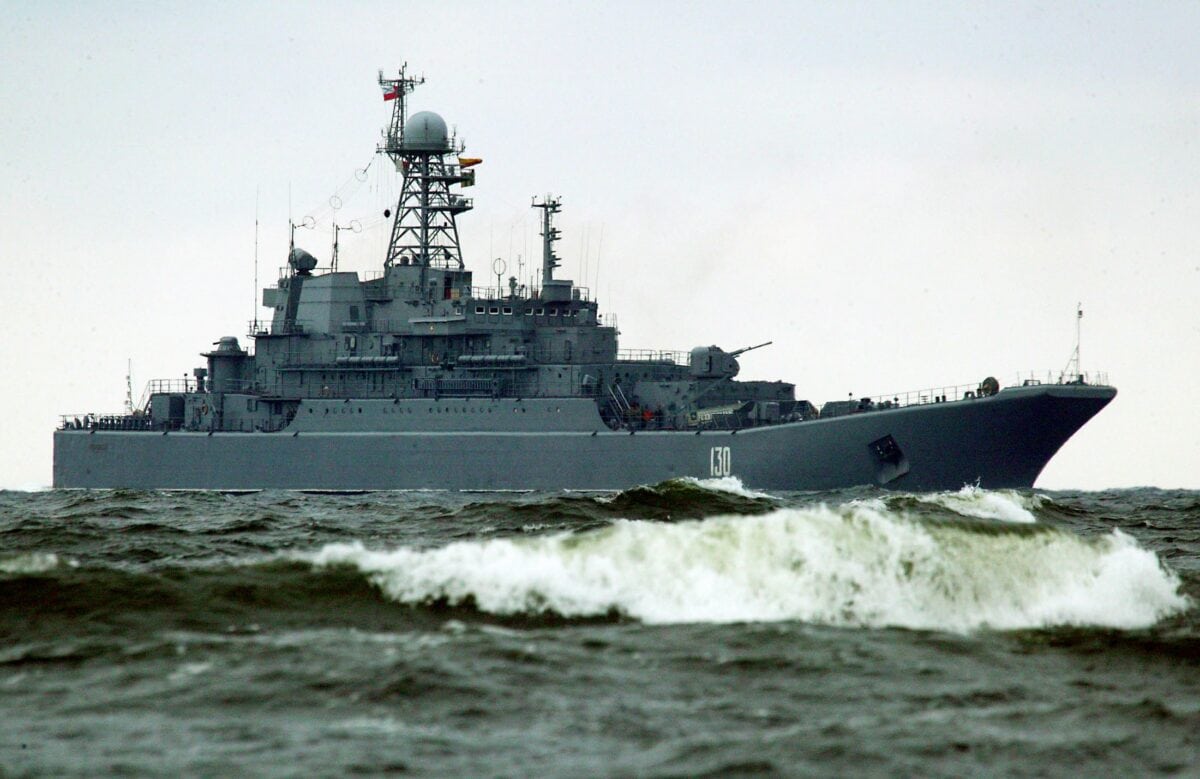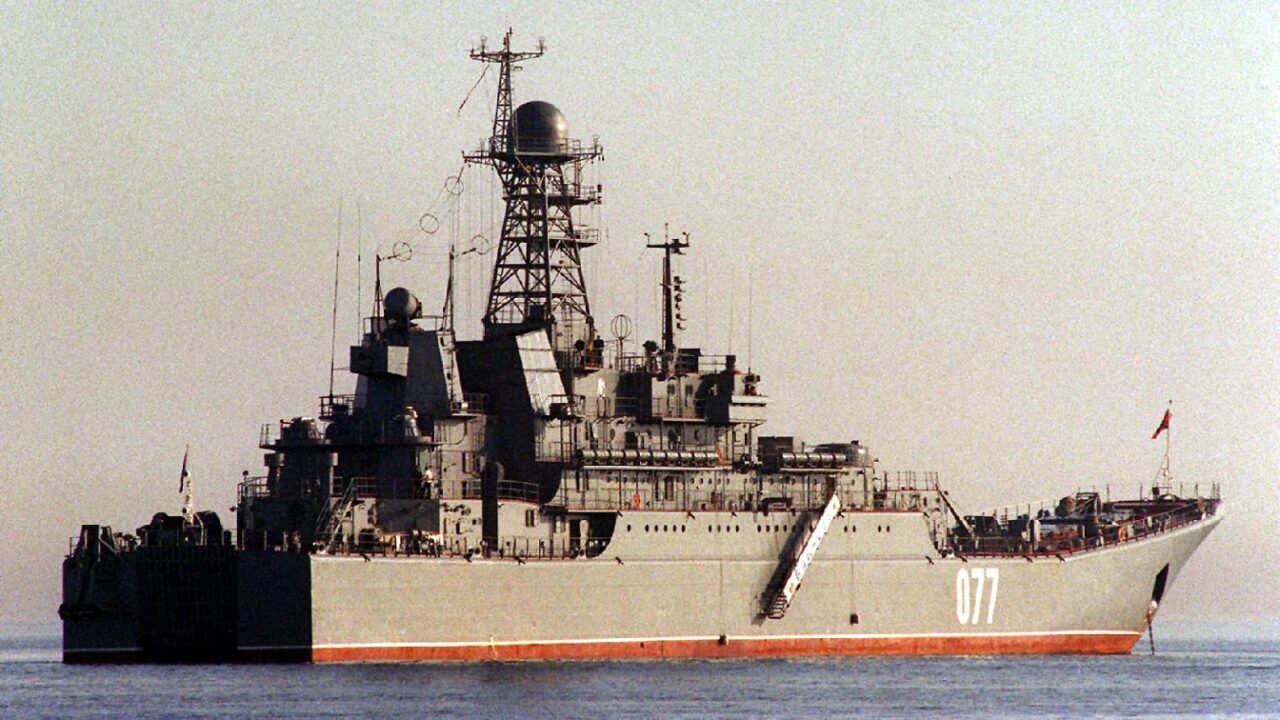Russia’s Ropucha Landing Ships Head Towards Ukraine—Is An Amphibious Landing In the Cards?: In the third week of January a total of six Russian amphibious landing ships departed the Baltic naval base of Kaliningrad. The first three—the Ropucha-class tank landing ships Korolev, Minsk and Kaliningrad tapped from the local Baltic Fleet—threaded through the English Channel on January 19 shadowed by various European navies.
Prior, three more ships departed from Kaliningrad, though this time the vessels had originated from Russia’s Arctic Northern Fleet. They included two more Ropuchas—the Olenegorskiy Gornyak and Georgiy Pobedonosets—plus the larger Ivan Gren-class landing ship Pyotr Morgunov.
1 IVAN GREN and 2 ROPUCHA passing under Storebæltsbroen (Great Belt Bridge) at 10’ish this morning. Thes nice photos are used with permission from Kurt Petersen, FB group “Under Broen”. Danish Patrol vessel P521 following the 3 RU vessels. pic.twitter.com/xZwcGC2S60
— Michael Christensen (@tekmic64) January 18, 2022
All six landing ships are heading for the Mediterranean, where they will reportedly be joined by warships from Russia’s Pacific fleet: the flagship missile cruiser Varyag, a fleet oiler, and an Udaloy-class anti-submarine destroyer.
Allegedly, this confluence is occasioned by an inter-fleet exercise. However, it appears likely these forces are ultimately bound for the Black Sea as part of a huge buildup of Russian military forces in the region which could culminate in an invasion of Ukraine.
It’s unclear how many troops and vehicles if any, are embarked on the amphibious ships. The Baltic naval base at Kaliningrad hosts the elite 336th Guards Naval Infantry Brigade. The six ships could potentially carry its two mechanized battalions and their BTR armored carriers and T-55 tanks. However, it’s debatable whether Moscow would strip forces from the strategically important base.
Russia’s Black Sea Fleet, meanwhile, officially has four Ropucha and three older but larger Alligator-class landing ships with a capacity for 20 tanks or 40 smaller fighting vehicles. Sevastopol also hosts the 810th Naval Infantry Brigade. If the landing ships departed from Kaliningrad end up joining those in the Black Sea—as seems likely—then that could total enough sealift to land a brigade-sized force on Ukraine’s coast.
Russia’s Caspian Sea Flotilla could also potentially transfer amphibious assets to the Black Sea via the Volga-Don canal, including seven smaller (25-meter long) landing boats and one 45-meter Dyugon-class landing craft.
Russia’s “Toad” Ships
Measuring slightly longer than a football field at 112.5 meters, the Ropucha-class tank landing ship (LST or BDK in Russian) can fit a company of 10 main battle tanks or twelve BTR or BMP armored personnel carriers in their holds; or alternately up to 550 tons of cargo or 20 trucks. They are designed to ground right up on a beach and disgorge troops and vehicles via a ramp lowered from the bow. As many Russian armored vehicles are amphibious, they can also launch vehicles miles away from shore and leave them to swim across under waterjet propulsion.
For self-defense, most Ropuchas (“Toads”) have two twin 57-millimeter automatic cannons and Strela-2M or Igla-S low-altitude air-defense missile launchers. But they also come with a powerful offensive capability: two Grad-M rocket launcher systems which each can release forty 122-millimeter rockets in rapid succession, drawing from a magazine of 320 rockets. These allow the landing craft to conduct preparatory bombardments and provide fire support for the embarked troops out to a range of 12.5 miles, or twice that using special 9M521 rockets.
The Polish shipyard of Gdansk built twenty-eight Project 775 Ropuchas for the Soviet Union through 1991. The final three, including Korolev and the BSF’s Azov were more modern Ropucha-IIs with improved defensive capabilities, including AK-176 rapid-firing 76-millimeter dual-purpose guns and two six-barrel AK-630 30-millimeter close defense gatling guns. They also sport improved MR-352 Positive radars, an MP-405 self defense jammer and a PK-16 system missile decoy launcher.

Photo by Belousov Maksim/Creative Commons/Ropucha-II Korolev in 2011.
The Soviet Union, and later Russia and Ukraine, deployed Ropuchas to evacuate citizens from conflicts in Ethiopia, Georgia, Libya and Yemen. The landing ships were also used to deploy Russian peacekeeping forces to the Balkans in 1999 and weapons and supplies to the Russian’s naval base of Tartus in Syria. At the end of the 2008 Russo-Georgia war, the Yamal and Saratov inserted Russian forces into the Georgian port of Poti to scuttle the Georgian fleet.
Until 2014 Russia had fifteen Ropuchas split between the Baltic, Black Sea, North and Pacific fleets. Ukraine’s Navy operated one, the Konstantin Olshansky. When Russian forces seized the Crimean Peninsula, her crew took the ship to sea to avoid capture, only for her to be blockaded and ultimately seized by Russian forces. Though Moscow suggested it might return the vessel to Ukraine, in July 2021 it was seen flying a Russian flag, and thus may arguably be counted the fifth Ropucha in the Black Sea Fleet.

100715-N-0046R-015 TENDRA, Ukraine (July 15, 2010) The Ukrainian navy ship LST Konstantn Olsnanskly (U 402) is anchored in the Black Sea during an exercise Sea Breeze 2010 anti-piracy exercise in the Black Sea. The exercise simulated landing on an island overrun by pirates. Sea Breeze is the largest exercise this year in the Black Sea, with 20 ships, 13 aircraft, and more than 1,600 military members from Azerbaijan, Austria, Belgium, Denmark, Georgia, Germany, Greece, Moldova, Sweden, Turkey, Ukraine, and the US.
Accompanying two Northern Fleet Ropuchas is the larger and more modern Ivan Gren-class landing ship Piotr Morgunov. Measuring 135-meters long, she can carry 13 main battle tanks or 40 BTR or BMP fighting vehicles, and 500 troops. Three 30-millimeter gun systems provide a close defense.
Atypically, the Morgunov has an aviation hangar that can support two Ka-29 armored assault transport helicopters or one Ka-52K naval attack helicopter. The Ka-52K boasts formidable firepower and agility, but Ka-29s might be preferred, as they can carry up to 16 troops as well as four weapon pods, and thus increase the throughput of soldiers landed ashore.
The Ivan Gren-class had a torturous path to operational service. The lead ship laid down in the Yantar shipyard in Kaliningrad in 2004 was left incomplete for years due to funding shortfalls and technical problems including engines that wouldn’t run in reverse and hull stability issues. But after France canceled delivery of two Mistral-class amphibious carriers in 2014 following Russia’s seizure of Crimea, construction recommenced to provide a partial substitute. The Gren launched in 2018, the Morgunov in 2020.
Two larger and wider (150×19 meter) Ivan Gren ships were laid down in 2019, due for launch in 2023 and 2024. These may have twice the tank and aviation capacity of the first two ships, more powerful engines and integrate a 76-millimeter gun.
How Might Russia Use its Amphibious Forces in a Conflict with Ukraine?
Maritime mobility and Ukraine’s long coastline on the Baltic and Azov seas give Russia multiple options on using naval infantry. However, landing operations are inherently difficult and risky. During World War II, a large-scale landing on the Crimean Peninsula in the winter of 1941-1942 was crushed in a week of fighting having sustained 42,000 casualties.
Ukraine’s Navy currently has no real surface warfare capability, but it does have patrol boats and Bayraktar drones that can surveil the waters around Ukraine that might warn of an amphibious landing, and potentially cue attacks by mobile batteries of Neptune anti-ship cruise missiles with a maximum range of 186 miles.
Russia’s military planners would have to balance the degree of potential opposition with proximity to friendly ground forces they could link up with. For example, a landing west of Mariupol in the Sea of Azov could facilitate that city’s capture in concert with ground forces advancing from the east, but would face dense defenses. Similarly, landing operations to help 21st Corps break out of Crimea and advance upon Kherson and Melitopol could benefit from nearby artillery support, but would contend with heavy opposition.
Alternatively, Russia could land forces in western Ukraine, forcing Kyiv to divert forces to contain the beachhead rather than reinforcing frontlines in eastern Ukraine. However, troops landed here would be distant from friendly air and ground forces and depend heavily on naval fires and air defense coverage.
Perhaps Moscow’s simplest option is to keep its amphibious forces in reserve—forcing Ukraine to set aside troops to defend against a possible landing that might never materialize. Of course, if a gap in the coastal defenses eventually opens up, a landing force could still swoop in. Ultimately, Russia’s amphibious forces constitute just one of many vectors Russia can threaten invasion of Ukraine—and far from the greatest in scope.
Sébastien Roblin writes on the technical, historical, and political aspects of international security and conflict for publications including the 19FortyFive, The National Interest, NBC News, Forbes.com, and War is Boring. He holds a Master’s degree from Georgetown University and served with the Peace Corps in China. You can follow his articles on Twitter.

